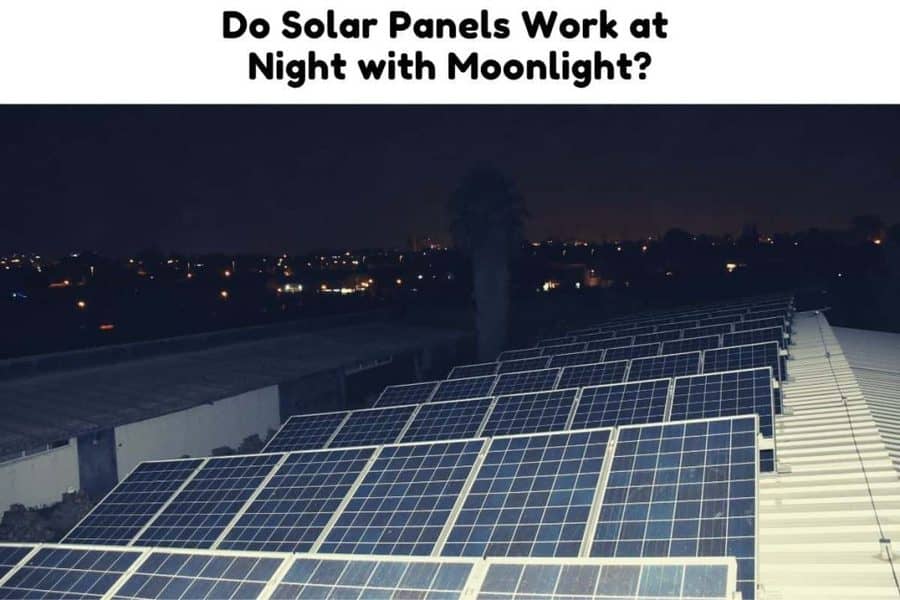It takes sunlight just over 8 minutes to reach Earth. The moon is much closer so it takes between 1 and 1/3 of a second for moonlight to get to Earth.
Moonlight, however, is not in fact light from the moon. What is called moonlight is sunlight being reflected by the moon. Except for gamma rays, the moon does not emit any light radiation.
Does this mean you cannot power a solar panel using moonlight? The answer to this question might surprise you. It turns out that you can power solar panels using the moon as your light source. However, the complete details of how solar panels work with moonlight are a little more complicated.
How is it that even on a full moon, when it is almost as bright as day, a solar panel will only produce a fraction of the energy it can produce? That is the main question we want to explore. By the end of this article, you will know how much energy a solar panel produces using moonlight. You will also discover why it does not produce as much as other light sources.
On a side note! If you’re in need of a reliable and high-performance portable solar panel, We strongly recommend the Jackery SolarSaga 100W Portable Solar Panel (Amazon Link).
With a high conversion efficiency and foldable design, this solar panel is easy to transport and set up, making it perfect for outdoor activities like camping, hiking, and RV trips.

The US solar cell technology used in this panel ensures that you get the most efficient and reliable solar charging possible.
There is also a 60W option that is more affordable (Amazon Link)

Do Solar Panels Charge Off Moonlight?
Solar panels can be charged from almost any source of light including moonlight. While you can charge a solar panel with moonlight, this produces a voltage far too low to be realistically used as a power source. There just isn’t enough energy in the moonlight to create a sizable electric current.
Solar panels use a broad spectrum of light that includes ultraviolet (UV), infrared and visible light to produce energy. Most of the light used to produce solar energy is visible light. The sun is the main source of light that solar panels produce energy from although you can use artificial lights like lasers or LED light bulbs.
The moon does not produce any light. What looks like the moon glowing is a small amount of sunlight reflecting off the moon. The light bounces off volcanoes, craters, and lava flow on the surface of the moon.
The brightness of moonlight depends on the lunar phase. Even at its brightest a full moon only provides an illuminance of between 0.05 to 0.1 lux. Sunlight on the other hand has a luminance of between 109 000 to 120 000 lux at high noon. That makes the sun more than 100 000 times brighter than the moon!
If the moon is reflecting light and any source of light can be used to produce energy, why then don’t we use moonlight to charge solar panels?
How Much Energy Does Moonlight Produce?
Moonlight does not carry anywhere near the same amount of energy as sunlight. The sun is a huge naturally occurring nuclear reactor that produces enough energy to power the earth for 500,000 years in just one second!
The sun provides approximately 1,368 watts of energy per square meter per second. Solar panels are engineered to work with this level of energy. Compared to the sun, the moon produces only 0.0006 watts per square meter. This means you would need about 2.3 million moons to produce as much energy as the sun does.
Moonlight produces energy in a solar panel at a ratio of 345:1.
A solar panel that produces 345 watts during peak sunlight hours would only produce about 10 watts on a full moon. That is barely enough energy to power a small LED. (Source)
Can We Generate Electricity from Moonlight?
You cannot generate usable electricity from a solar panel using moonlight. Solar panels generate less than 0.3% of their potential energy output from moonlight. A 300-watt solar panel for example would only produce less than 1 watt of energy from moonlight.
Solar panels need light to produce energy and moonlight does not provide near enough light to generate electricity. Moonlight is a reflection of only 12% of sunlight. To illustrate how little light this is, a silvered glass mirror at midday reflects 99% of sunlight. With that loss of light comes a corresponding loss in energy output.
Light contains photons that energize the electrons in a solar panel and create an electric current. The less light there is, the fewer photons there are available to create an electric current through the process of a photovoltaic effect. As it is reflected light and not direct light from the sun, moonlight has far fewer photons from which to generate electricity.
Naturally, the next question most people would have at this point is how solar works at night. If you cannot generate electricity from moonlight, how will a solar system provide you with energy at night?
Do Solar Panels Work at Night?
Solar panels do not work at night. You can however get energy at night from stored solar energy. Batteries are used in this case to store the solar energy generated by solar panels during the day so the energy can be used at night.
Batteries have extended the capability of a solar panel beyond just daytime use. Having energy storage allows you to use solar both during the day and at night.
In the daytime, solar panels charge the batteries until they reach their full capacity. At night after the solar panels stop producing energy, you can then switch to using the stored energy from the batteries.
There are different types of batteries used in solar installations. The most popular options for solar batteries are lead-acid and lithium batteries. While they are more expensive, lithium batteries provide more energy than lead-acid batteries.
At present, batteries are the only way through which solar energy can be used at night. Typically, you will find batteries in an off-grid solar system although you can use them in a grid-tie system. While batteries might be the only way you can use solar at night there is, however, research into solar panels that work at night.
Researchers at Stanford University have developed a solar panel that produces a small amount of energy. The solar panel creates thermoelectric energy by exploiting the difference in temperature between the solar panel and the ambient temperature.
